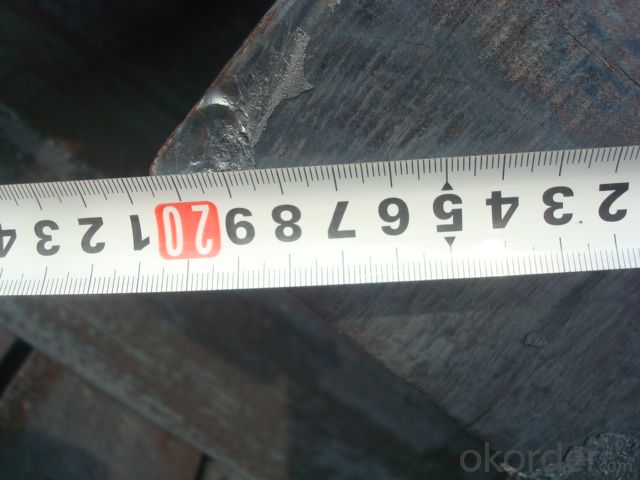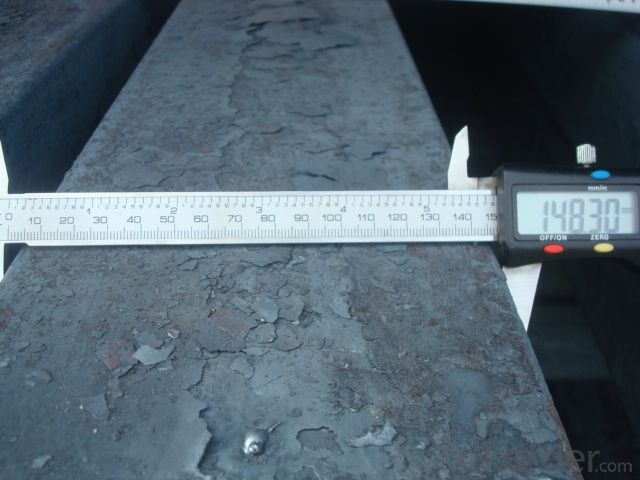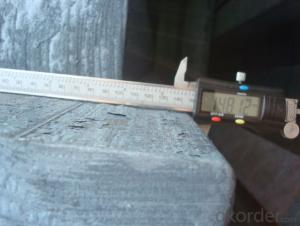Continuous Casting Steel Billet Q275/235
- Loading Port:
- Tianjin
- Payment Terms:
- TT OR LC
- Min Order Qty:
- 1000 m.t.
- Supply Capability:
- 200000 m.t./month
OKorder Service Pledge
OKorder Financial Service
You Might Also Like
STEEL BILLET
1.Structure of Steel Billet
Steel billet(ingot) by cogging or breakdown of semi-finished products, is the raw material of all kinds of steel mill. Billet section of square, round, flat, rectangular and abnormity of several kinds of, mainly related to the shape of rolled products.
2.Main Features of Steel Billet
Rectangular billet continuous casting billet and mainly general carbon steel, low carbon low silicon cold-rolled material, high quality carbon structural steel, high strength low alloy steel, special steel, etc.
The billet is mainly divided into two kinds from the shape:
Slab: cross section width and height of the ratio of the larger, mainly used for rolling plate.
Billet: equal cross section width and height, or a huge difference, mainly used for rolling steel, wire rod. ,
Steel billets have distinct characteristics as compared with already furnished steel bars and products. Billets have a specific grain structure, which enables the metal to be processed more intricately. Steel billets are also known for their malleability and ductility, especially when exposed to varying temperatures during shaping and molding.
3.Processing of Steel Billet
Steel billets are considered fresh and raw, and they must undergo a series of manufacturing processes before they can be used for various purposes. Billets are made by means of freezing molten liquid, and are later exposed to extremely low temperatures in order to allow the metal to take shape and solidify in chemical structure. The temperature manipulates the metal's physical properties, and tones its strength and durability. The subsequent processes provide the metal's curved mold design so that it can fit the allotted space provided by other machines, which complete the finishing procedures.
4.Steel Billet Images


5.Usage of Steel Billet
Billets, or ingots (as they sometimes referred to), are not of practical use until they have been formed into more functional shapes and sizes. While they have already been put in the furnace, they still require a series of shaping and molding procedures such as hot and cold working, milling and cutting before they are sold in hardware stores, or used for different applications. The unformed billets, however, can be used in striking currency such as coins and as reserves, similar to gold bars.
6. Steel Billet Specification
Hot rolled billet steel
Size: 50x50mm-180x180mm
Steel Grade: 3SP, 5SP,Q195,Q235,Q255,Q275 Length:3m-12m
MOQ: 1000MT/size
Payment term: TT or LC
Packing: in bulk , bundle
Shipment: by container , bulk vessel
Packaging Details: bundles with steel strips or as customers's requirements
Delivery time: 15-30 days after the deposit
Loading port:Tianjin, or other port China
Origin :China
Inspection:Third party inspection before loading.
7.FAQ
We have organized several common questions for our clients,may help you sincerely:
1) How about your company?
A world class manufacturer & supplier of castings forging in carbon steel and alloy steel,is one of the large-scale professional investment casting production bases in China,consisting of both casting foundry forging and machining factory. Annually more than 8000 tons Precision casting and forging parts are exported to markets in Europe,America and Japan. OEM casting and forging service available according to customer’s requirements.
2) How to guarantee the quality of the products?
We have established the international advanced quality management system,every link from raw material to final product we have strict quality test;We resolutely put an end to unqualified products flowing into the market. At the same time, we will provide necessary follow-up service assurance.
3)If there’s something wrong with the quality of the products, how do we return the goods?
We promise you the quality will be the same as the samples you confirmed. If there’s something wrong with the quality of the products, please send back sample from the shipment goods to us and let us know the quantity, then we will investigate in our work shop. If it is our problem, we will offer you discount or replacements for free.
- Q:How are steel billets used in the manufacturing of industrial machinery?
- Steel billets are an essential component in the manufacturing of industrial machinery. These billets are semi-finished products that are produced through a process called continuous casting, where molten steel is poured into a mold to form a solid rectangular shape. Once the steel billets are formed, they undergo various processes to transform them into different components of industrial machinery. One common use of steel billets is in the production of machine parts such as gears, shafts, and axles. These components require high strength and durability to withstand the rigorous demands of industrial applications, and steel billets provide the necessary material properties. Steel billets are also used in the manufacturing of large structural components such as frames, bases, and supports for industrial machinery. These components need to be able to handle heavy loads and provide stability, and the use of steel billets ensures the necessary strength and rigidity. Furthermore, steel billets serve as raw material for forging, where they are heated and shaped using mechanical force to create complex shapes like crankshafts and connecting rods. The high malleability and ductility of steel billets make them ideal for forging, allowing manufacturers to produce intricate and precise components for industrial machinery. In addition, steel billets are often used in the production of specialized machinery, such as rolling mills and presses, which are used in various industrial processes. These machines require robust components that can withstand high temperatures, pressures, and forces, and steel billets provide the necessary strength and resilience. Overall, steel billets play a vital role in the manufacturing of industrial machinery as they provide the necessary strength, durability, and versatility required for producing various components and structures. Their use ensures the reliability and performance of industrial machinery in a wide range of applications.
- Q:Are steel billets used in the production of sporting goods?
- Yes, steel billets are commonly used in the production of sporting goods. They are often utilized to create various components such as the shafts of golf clubs or the frames of bicycles. Steel billets provide durability and strength to these sporting goods, making them suitable for intense physical activity.
- Q:What is the typical tensile strength of a steel billet?
- The typical tensile strength of a steel billet can vary depending on the specific grade and composition of the steel. However, in general, steel billets have a tensile strength ranging from 370 to 550 megapascals (MPa). This range is commonly found in low to medium carbon steels used for various applications in industries such as construction, automotive, and manufacturing. It is important to note that higher-grade steels, such as alloy steels, can have significantly higher tensile strengths, exceeding 1000 MPa. Ultimately, the tensile strength of a steel billet is determined by its intended application and the specific requirements of the project.
- Q:How are steel billets preheated before processing?
- Steel billets are typically preheated before processing using a variety of methods such as induction heating, gas-fired furnaces, or electric resistance heating. These techniques raise the temperature of the billets to an optimal level, ensuring they are ready for further processing, such as rolling or forging.
- Q:What are the main factors affecting the metallurgical properties of steel billets?
- The metallurgical properties of steel billets are influenced by several key factors. These factors encompass the steel's composition, the applied heat treatment, the presence of impurities, and the rate at which it cools. The composition of the steel plays a pivotal role in determining its metallurgical properties. The steel's strength, hardness, and ductility are significantly impacted by the amount of carbon present, as well as the inclusion of other alloying elements like manganese, chromium, and nickel. Additionally, different compositions can affect the steel's ability to resist corrosion or exhibit magnetic properties. Heat treatment is another crucial factor that affects the metallurgical properties of steel billets. Through this process, the steel is heated to a specific temperature and then cooled at a controlled rate. By altering the steel's microstructure, heat treatment influences its hardness, toughness, and overall mechanical properties. Various methods of heat treatment, such as annealing, quenching, and tempering, can be employed to achieve desired metallurgical properties. The presence of impurities in the steel also has an impact on its metallurgical properties. Impurities like sulfur, phosphorus, and oxygen can have negative effects on the steel's mechanical properties, diminishing its strength and ductility. Hence, minimizing the level of impurities is crucial to ensure the desired metallurgical properties. Lastly, the cooling rate during the solidification process plays a pivotal role in determining the steel billets' microstructure and properties. Rapid cooling, as seen in quenching, leads to a fine-grained microstructure that enhances the steel's strength and hardness. Conversely, slow cooling, such as during annealing, results in a coarse-grained microstructure that improves the steel's ductility and toughness. In conclusion, the metallurgical properties of steel billets are influenced by factors such as composition, heat treatment, impurities, and cooling rate. These factors are interconnected and must be carefully controlled to achieve the desired properties for various applications.
- Q:How are steel billets coated or painted?
- Steel billets can be coated or painted through several methods. One common technique is hot-dip galvanizing, where the billets are immersed in a bath of molten zinc. This process forms a protective zinc coating on the surface of the steel, preventing corrosion. Another method is electroplating, which involves the deposition of a thin layer of metal, such as zinc or nickel, onto the billets using an electric current. Additionally, steel billets can be painted using various coating systems, such as powder coating or liquid paint, to provide a decorative finish or additional protection against rust and environmental factors.
- Q:How long do steel billets last?
- The longevity of steel billets varies depending on multiple factors, including their storage conditions and utilization. Provided that they are stored appropriately in a controlled environment with low humidity and shielded from corrosion, steel billets can endure indefinitely. Conversely, if they are exposed to harsh weather, excessive moisture, or corrosive substances, their lifespan can be significantly diminished. As for their usage, steel billets are typically melted and transformed into other steel products, such as bars, rods, and beams. The lifespan of the final product hinges on its specific application and the maintenance practices implemented. Generally, steel products are renowned for their durability and longevity, rendering them a dependable option in numerous industries.
- Q:How are steel billets used in the manufacturing of food processing machinery?
- Food processing machinery relies on steel billets for the production of various components and structures. These billets undergo heating and rolling processes to form steel bars, rods, or sheets of different shapes and sizes. These steel products are then utilized in the construction of the framework, body, and other parts of the machinery. Steel's high strength and durability make it an ideal choice for food processing machinery, which often operates in harsh conditions and requires resistance to corrosion, wear, and high temperatures. Steel billets are carefully selected for their quality and suitability for the intended application. When constructing food processing machinery, steel billets are employed in fabricating crucial components like cutting blades, mixing paddles, conveyor belts, and grinding plates. These components are vital for the efficient processing and handling of food products, ensuring consistent quality and safety. Furthermore, steel billets are also used in manufacturing structural supports, frames, and housing for machinery. These structures provide the necessary stability, rigidity, and support to ensure the proper functioning and longevity of the food processing equipment. In conclusion, steel billets play a vital role in the manufacturing of food processing machinery as they provide the essential raw material required to create durable, reliable, and efficient equipment. The quality and characteristics of steel contribute to the performance, safety, and hygiene standards demanded in the food processing industry.
- Q:What types of steel are commonly used for billets?
- The types of steel commonly used for billets include carbon steel, alloy steel, and stainless steel.
- Q:What are the potential applications of steel billets in the transportation aftermarket?
- Steel billets have various potential applications in the transportation aftermarket. They can be used for manufacturing various components such as engine parts, suspension systems, chassis, and body structures. Steel billets offer excellent strength, durability, and reliability, making them suitable for heavy-duty applications in the transportation industry. Additionally, their versatility allows for customization and adaptability to meet specific requirements. Overall, steel billets play a crucial role in enhancing the performance, safety, and efficiency of vehicles in the transportation aftermarket.
1. Manufacturer Overview |
|
|---|---|
| Location | |
| Year Established | |
| Annual Output Value | |
| Main Markets | |
| Company Certifications | |
2. Manufacturer Certificates |
|
|---|---|
| a) Certification Name | |
| Range | |
| Reference | |
| Validity Period | |
3. Manufacturer Capability |
|
|---|---|
| a)Trade Capacity | |
| Nearest Port | |
| Export Percentage | |
| No.of Employees in Trade Department | |
| Language Spoken: | |
| b)Factory Information | |
| Factory Size: | |
| No. of Production Lines | |
| Contract Manufacturing | |
| Product Price Range | |
Send your message to us
Continuous Casting Steel Billet Q275/235
- Loading Port:
- Tianjin
- Payment Terms:
- TT OR LC
- Min Order Qty:
- 1000 m.t.
- Supply Capability:
- 200000 m.t./month
OKorder Service Pledge
OKorder Financial Service
Similar products
New products
Hot products
Related keywords





























